
December 19, 2014
He Bought An Electric Fence To Prevent Burglaries. Then This Happened.

December 19, 2014

December 18, 2014
December 17, 2014
December 16, 2014
December 09, 2014
It’s that time of year when we’re all trying to figure out a gift that fits the person we’re buying for and that shares the message, “You’re special to me.” Here are some suggestions to make that easier.
Chip Hines
Some of our On Pasture readers have told us that they like Chip’s articles the best. In fact, some of the articles we’ve shared with you are excerpts from the books he has written. Chip shares his unique experience and understanding of the challenges involved in producing sustainable in the books he writes. You can find and read more about them here.
Forrest Pritchard
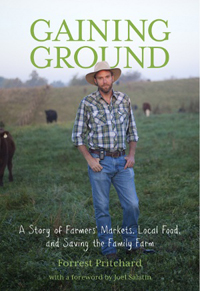 Forrest’s first book, Gaining Ground: A Story of Farmers’ Markets, Local Food, and Saving the Family Farm, came out just about the time that On Pasture was getting started. We were honored to be able to share an excerpt from the book with readers (which you can still read here), and have been tickled to see the rave reviews our friend has gotten ever since. In fact, his book was named a top read by The Washington Post, Publishers Weekly and NPR’s The Splendid Table! Forrest has share a lot of “How To” articles with On Pasture readers and with this book, you’ll get some behind the scenes stories to put them in perspective. You can read more about the book and order it here.
Forrest’s first book, Gaining Ground: A Story of Farmers’ Markets, Local Food, and Saving the Family Farm, came out just about the time that On Pasture was getting started. We were honored to be able to share an excerpt from the book with readers (which you can still read here), and have been tickled to see the rave reviews our friend has gotten ever since. In fact, his book was named a top read by The Washington Post, Publishers Weekly and NPR’s The Splendid Table! Forrest has share a lot of “How To” articles with On Pasture readers and with this book, you’ll get some behind the scenes stories to put them in perspective. You can read more about the book and order it here.
Kathy Voth
Before Rachel and I started On Pasture, I traveled the U.S. and Canada, training cows, sheep and bison to eat weeds, and doing workshops and presentations to show farmers and ranchers how they could turn weeds into forage by teaching their livestock to eat them. Along the way I wrote a book with all the instructions and lessons I learned about how to train cows in just 8 hours over 7 or so days. You can download the first three chapters of the book here, and you can purchase the book here. If seeing it is better than reading it, I made a how-to video as well. Here’s link to that and and some other things of interest.
Sandra K. Miller
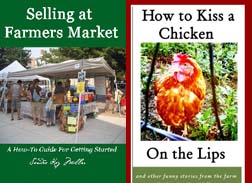 Sandy is an amazing farmer, photographer, chef, and author. She’s participated in the founding of a number of farmer’s markets and producer organizations. If you’re thinking of dipping your toes (or diving head-first) into the world of direct marketing, Sandy’s book Selling at Farmers Markets, is for you. Her book How to Kiss a Chicken On the Lips and Other Funny Stories From the Farm is for anyone how has fantasized about giving up the cubicle for a tractor. Sandy lays out the realities of farm life as she takes us through the heart and history of the local foods revolution.
Sandy is an amazing farmer, photographer, chef, and author. She’s participated in the founding of a number of farmer’s markets and producer organizations. If you’re thinking of dipping your toes (or diving head-first) into the world of direct marketing, Sandy’s book Selling at Farmers Markets, is for you. Her book How to Kiss a Chicken On the Lips and Other Funny Stories From the Farm is for anyone how has fantasized about giving up the cubicle for a tractor. Sandy lays out the realities of farm life as she takes us through the heart and history of the local foods revolution.
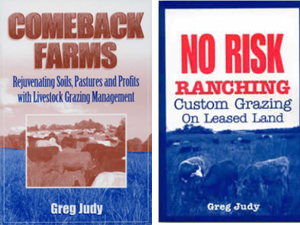 Greg Judy
Greg Judy
Greg is known for figuring out how to make raising beef pay using leased land and managing his herd as a mob to improve soil and increase forage. His no-nonsense books share his knowledge so that you can apply it to your own operation. Click here to order.
Jim Gerrish
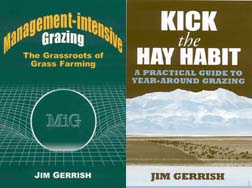 Jim is the author of the popular books Management-Intensive Grazing and Kick the Hay Habit. Loads of farmers and ranchers have used the information in his two books to improve grazing management and cost control on their operations. Click here to order.
Jim is the author of the popular books Management-Intensive Grazing and Kick the Hay Habit. Loads of farmers and ranchers have used the information in his two books to improve grazing management and cost control on their operations. Click here to order.
Trish Weil
Recognize that last name? Yes! Trish Weil is the wife of On Pasture author Ray Weil and she’s an author in her own right. Her new book, A Circle of Earth, is set in Alabama between and following the two world wars, and tells the story of two characters’ attempts to find happiness in a world where both lives and marriages are defined not by choice but by circumstance. We’re lucky enough to be able to provide you with an excerpt of the book. You can also learn more about it and purchase it as a paperback or as a kindle book here.
Bill Beaman
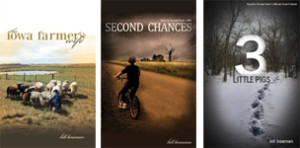 Bill Beaman is an Iowa farmer who raises beef cows and sheep and loves to tell good stories to entertain people, and that’s just what he’s done with his first three books, The Iowa Farmer’s Wife, Second Chance, and 3 Little Pigs, a trilogy that takes place is rural farm country. Beaman’s books are available in paperback and Kindle on Amazon or at his website, theiowafarmer.com.
Bill Beaman is an Iowa farmer who raises beef cows and sheep and loves to tell good stories to entertain people, and that’s just what he’s done with his first three books, The Iowa Farmer’s Wife, Second Chance, and 3 Little Pigs, a trilogy that takes place is rural farm country. Beaman’s books are available in paperback and Kindle on Amazon or at his website, theiowafarmer.com.
Of course you could always start with an On Pasture T-Shirt. ![]() Head to the On Pasture Shop to pick out your size and color. You’ll also see that you can simply give the gift of On Pasture. One size fits all, and we’ll even send you both a bumper sticker!
Head to the On Pasture Shop to pick out your size and color. You’ll also see that you can simply give the gift of On Pasture. One size fits all, and we’ll even send you both a bumper sticker!
Gloves

One of our On Pasture sponsors is Texas Good Gloves. Everybody can use gloves!
Lyal Strickland is a singer, songwriter and farmer raising grassed herefords in the Missouri Ozarks. You can listen to his music here, and you can order his CDs here.
Electric Fencing
Can you imagine what your friend or loved one would say to a great electric fence charger under the Christmas tree? Oh – but don’t hook it up TO the tree. Some surprises aren’t so good. ![]()
Zombie Goods
My friend Leah Ashley Esser and I had fun with a project we called “Zombie Victory Gardens” to help newbie gardeners prep for the Zombie Apocalypse by growing food in their own backyards. You can make sure that you’re ready with an “In Case of Zombie Apocalypse Save Me First! I’m a Farmer” t-shirt or hoodie. Limited sizes and styles left, so if you want one…. We also have a great set of WWII Victory Garden-themed posters for your “Walking Dead” enthusiast, just $1 each. And for the serious gardener, there’s a whole series of veggie earrings. You probably know someone who needs 2-Carrot Earrings!
December 08, 2014
The Gallagher B1200 electric fence charger has a high (H), medium (M), and low switch on it (L). If you have it set on high the fencer will read around 6Kv to 7Kv or a little higher. You need to make sure that you're using an electric fence tester that's designed to test for electric fence voltages and not using a standard AC DC volt meter, you'll either burn up the meter or get a fluctuating of numbers, which won't make any since. You'll take the ground probe of the tester and put it on the Green terminal of the B1200 and the other part of the tester on the Red terminal of the B1200, then turn it on to the high switch setting and see what voltages you're getting on the screen of your tester. If it's upwards to 6Kv or higher your fencer is good, if it's quite a bit lower then there's something not quite right with the B1200.
The fence voltage can vary in a good way or bad way.You'll use the same tester you used one the B1200 to test the fence. You'll take the ground probe of the tester and push it into the ground and lay the hot part of the tester on the fence itself. If it shows 6Kv or higher then you're fence is in good shape. If it's between 4Kv and 5Kv, you're fence is in OK condition, but you may have some shorts dogging down on the fence or your ground system is inadequate for that size of charger. If the voltage is below 4Kv, then you definietly have some issues going on with the fence.
The B1200 is quite a powerful fencer, definietly don't want to grab the wire espescially if the B1200 is working good. There's a trick of trade from the old days for testing the electric fence without using a tester and without grabbing the wire with your bare hand. What you'll need to get is a longer piece of green grass about 8 or so inches long. Squat down to a knee, pinch one end of the blade of grass between your thumb and index finger and lay the other end on the fence wire. You should feel a slight ping in the blade of grass. As you move the blade of grass inwards the ping will get stronger, so be wary of moving the blade of grass to close if you can already feel it. The green blade of grass will eat up about 90% of the shock.
If I was to be looking into a good fence tester that will do fine for reading voltages I would go with the Gallagher DVM3. You can look at your local farm store that carries Gallagher or go to the following link.
Hopefully this helps you out and points you into the right direction.
December 07, 2014
Unfortunately you can't use a regular volt meter for testing electric fence chargers, they're just not designed for the high voltage (7Kv to 9Kv) pulse. You have to use an electric fence tester, preferably a digital one, to test any kind of fence charger or the fence itself. We recommend the Gallagher DVM3 for a tester. They work great and will work almost any brand of fencer from the very old to the very new, big and small.
December 06, 2014
December 03, 2014
Electric fence can be a cost effective method of housing cattle, sheep and goats in large areas. Electric fence design and parts needed can be intimidating if you are not familiar with it. Careful planning will make it easy.
You will need an electric fence charger, also known as a controller or energizer or electric fencer. Fence chargers come in several different power configurations. These are solar powered, Battery powered, and mains or AC powered.
Its important to locate the heart of your fence in a strategic spot, like a barn, corner, or gate opening. Its a good idea to house the energizer in a water proof covering or indoors to protect it from weather. Solar electric fence chargers need to be outdoors and facing the midday sun. Solar fencers house an internal battery which operated the unit. the solar panel keeps it charged.
A ground system in needed for the energizer and should be located close to it. WE recommend at least three, 6 foot rods. they come in copper, or steel with a galavinzed coating. Its important not to mix metals when it comes to ground wire and rods, if its copper rods, use copper wire to connect it to the charger. Use clamps to attach the ground rod to the ground wire.
The next step is laying out your fence post according to your plan. You may need several on hills and valleys to compensate for rises. where in straight aways you can space them out quite a bit. Use high quality fence insulators for your wire. There are many types of wire. polywires, and tapes available. For temporary fences that will be moved, turbo wire is easy to use and cost effective.
For Cattle 1 to 4 wires can work well. For sheep and goats, the more wires the better. Metal wire will act as a physical barrier to help keep them contained. When you have the wires installed, make sure you connect them together so they will all have energy to them. Then connect the energizer to the top wire.
Before starting the system, carefully inspect the fence for any possible faults or problems. Use a digital fault finder or voltmeter once you have the system running to check the preformance.
You should see at least 5000 volts in the fence, If not, check for faults and fix.
Your new fence will be a great asset to your farm if you spend the time and plan it right, build it well, and use high quaility parts from Valley Farm Supply.
December 02, 2014
Check out our latest advertisement that links back to our webite that contains savings on high quality electric fence chargers and accessories. This ad is listed at Onpasture.com It also is on several blogs about farming and cattle. Its for gallagher electric fence and Valley Farm Supply LLC